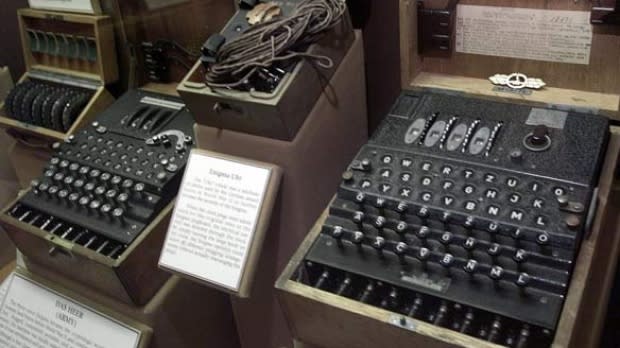'This really turned the tide': The Enigma machine and World War II in spotlight at U of A
It was created to be an unsolvable puzzle and its moniker, the Enigma, indicates as much.
This year marks the 100th anniversary of the first patent for the Enigma machine, a device used to encrypt secret communications for the German military during World War II.
The machine exists at the nexus of military history, computing science, and mathematics, which could explain the 500-person crowd that's expected to attend a public lecture on the Enigma at the University of Alberta this week.
The event is currently sold out but the university is hoping to broadcast the talk via its Facebook page on Thursday.
"Cracking the Enigma machine and other encryption technologies was paramount to Allied victory during the war and remains one of the greatest secrets of World War II," said David O'Keefe, a Montreal-based historian who will be presenting at the lecture, in a news release.
The machine looks similar to a typewriter. But the technology behind it essentially allowed each letter typed into the machine to be "mapped" onto another letter of the alphabet. The recipient of the message would be given the key to set their machine in the same way.
"The machine would dynamically reset its 'logic' and so next time you want to encrypt that letter, it would be mapped onto another letter," said Peter Berg, a University of Alberta professor of mathematics and physics, speaking on CBC's Radio Active on Monday.
"It gives you so many combinations of encrypting a text message that the Germans thought it was safe."
The Imitation Game
The efforts of British mathematicians to crack the German codes were captured in the 2014 film, The Imitation Game, starring Benedict Cumberbatch and Keira Knightley.
But Berg said their calculations and history-changing work were preceded by the efforts from other groups. A trio of young, Polish mathematics students managed to "reverse engineer" a German military Enigma machine, which contributed to later efforts in Britain to decipher the codes.
"Without the work of the Poles I'm not sure that Bletchley Park would have been able to crack the code so quickly," said Berg, referring to the location where the British code breakers worked.
"The key was to crack the Enigma communication of the north Atlantic where the U-boat war was raging...that was the most difficult thing to do. The Germans advanced the machine for that purpose the most."
The Enigma legacy
Berg, who will be speaking at Thursday's event, characterized the moment when Bletchley Park broke the code of the Atlantic network as "turning the tide quickly, almost instantaneously" in the war.
"It was then clear for the convoys that were trying to get supplies to Britain from north America, where the U-boats were...before that it was grim in the Atlantic for the allies, this really turned the tide," he said.

The Germans continued to improve the encryption of their communication through the war, which complicated efforts for the Allies.
At Thursday's lecture, it's expected O'Keefe will argue the real reason behind the Allies' raid of Dieppe in 1942 was to capture the most advanced German Enigma, which was believed to have a fourth rotor to make the encryption even more difficult to decipher.
"The Allies knew it was coming...and O'Keefe argues that it was the No. 1 objective of the raid, which was unsuccessful but had a very noble cause," said Berg.

